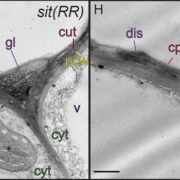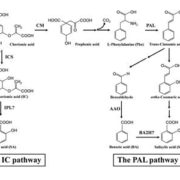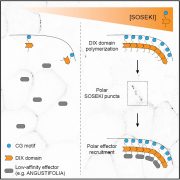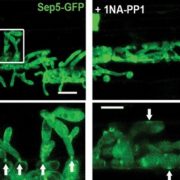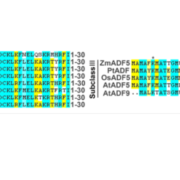SNARE proteins in replication vesicle trafficking of turnip mosaic virus ($) (Plant Cell)
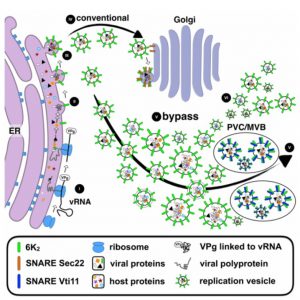 When plant cells are infected by RNA viruses, viral replication complexes are generated in organelle-like structures. These vesicles are important for the replication of viral RNA (vRNA) as well as moving vRNA-protein complexes through plasmodesmata to infect other plant cells. When turnip mosaic virus (TuMV) infects Nicotiana benthamiana, the viral membrane protein 6K2 has an important role in the release of these replication vesicles from the plant endoplasmic reticulum. This paper elucidates the role of the proteins 6K2, Sec22 and VTI11 in TuMV infection using protein studies, plant infection studies and microscopy. 6K2 contains a GxxxG motif that is essential for TuMV infection. If the motif is mutated, the viral protein is mislocated to the Golgi apparatus and the plasma membrane. Using co-immunoprecipitation, 6K2 co-purified with Sec22, a SNARE, and VTI11, a pre-vacuolar compartment SNARE. Overexpression of Sec22 in Nicotiana benthamiana resulted in increased intercellular movement of TuMV. Additionally, an Arabidopsis thaliana vti11 mutant was resistant to TuMV infection. These results indicate the TuMV replication vesicles use an unconventional pathway that does not include the Golgi apparatus, but may include pre-vacuolar compartments or multivesicular bodies. (Summary by Julia Miller) Plant Cell 10.1105/tpc.18.00281
When plant cells are infected by RNA viruses, viral replication complexes are generated in organelle-like structures. These vesicles are important for the replication of viral RNA (vRNA) as well as moving vRNA-protein complexes through plasmodesmata to infect other plant cells. When turnip mosaic virus (TuMV) infects Nicotiana benthamiana, the viral membrane protein 6K2 has an important role in the release of these replication vesicles from the plant endoplasmic reticulum. This paper elucidates the role of the proteins 6K2, Sec22 and VTI11 in TuMV infection using protein studies, plant infection studies and microscopy. 6K2 contains a GxxxG motif that is essential for TuMV infection. If the motif is mutated, the viral protein is mislocated to the Golgi apparatus and the plasma membrane. Using co-immunoprecipitation, 6K2 co-purified with Sec22, a SNARE, and VTI11, a pre-vacuolar compartment SNARE. Overexpression of Sec22 in Nicotiana benthamiana resulted in increased intercellular movement of TuMV. Additionally, an Arabidopsis thaliana vti11 mutant was resistant to TuMV infection. These results indicate the TuMV replication vesicles use an unconventional pathway that does not include the Golgi apparatus, but may include pre-vacuolar compartments or multivesicular bodies. (Summary by Julia Miller) Plant Cell 10.1105/tpc.18.00281


